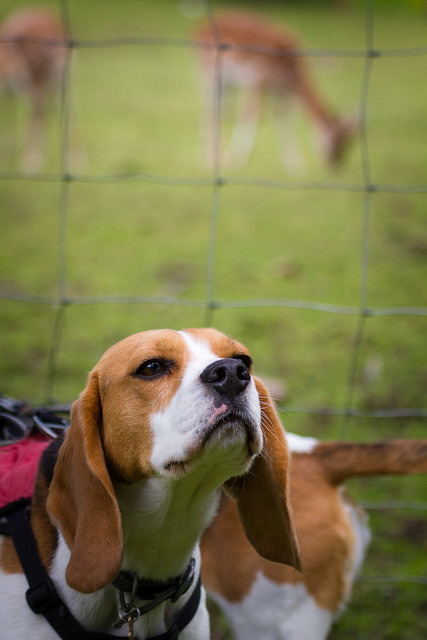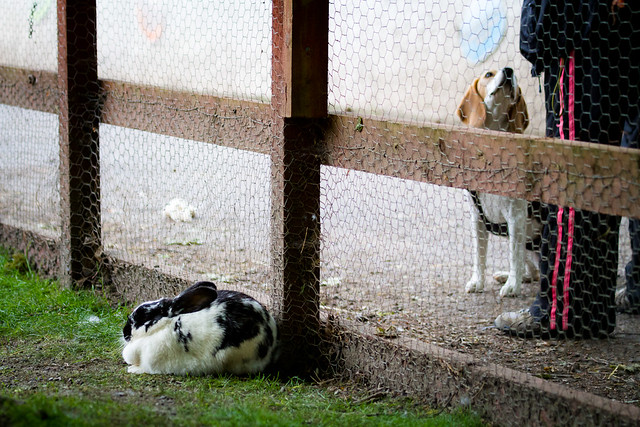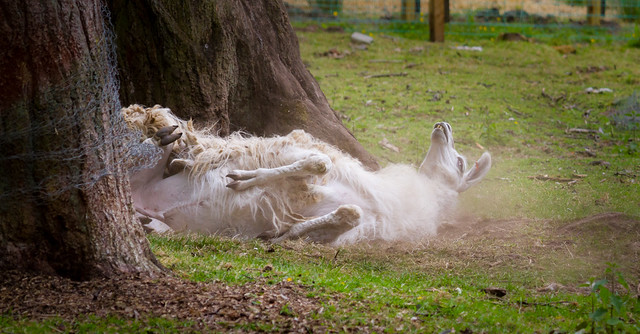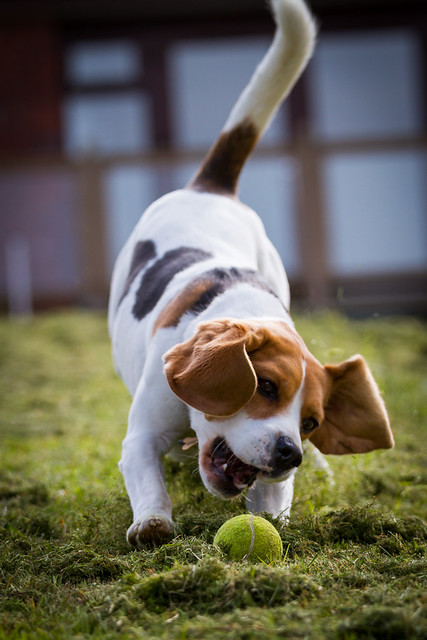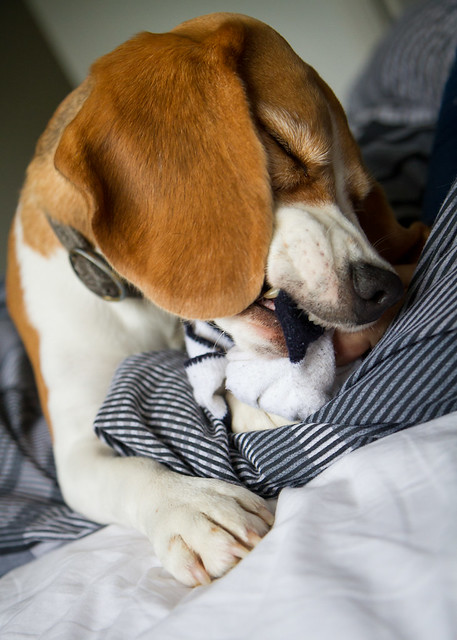Our recent trip to Skye – though very enjoyable – was somewhat marred by Beanie & Biggles’ reaction to sheep. Admittedly Skye is a bit of an extreme case in that it is absolutely teaming with the blummin’ things, but nevertheless it joins a long line of adventures that have featured unwelcome and prolonged baying/pulling frenzies.
From time to time we’ve tried to tackle this problem using the typical dog training suggestions:
- stopping dead when the baying starts and refusing to move until calm has been restored
- abruptly changing direction at the first sign of a freakout
- trying to distract Beanie & Biggles by getting them to perform tricks etc. when sense they’re about to lose control
- trying to engage them in games
Thus far all these approaches have either failed outright or proved hopelessly impractical. For example the stopping dead approach serves only to build frustration and stress in our dogs (especially Biggles) and they’re quite able to keep up a baying frenzy for several hours at a time. Changing direction isn’t always practical and anyway quite often we’ve completely run out of alternative directions (even the way we’ve just come, which was walked calmly, can suddenly become a trigger for more baying). As for games and food, well you can actually put food in Beanie & Biggles’ mouths when they’re in a highly excited state, and it’ll just fall out onto the floor. Yep, they get so worked up that even food won’t cut through!
The worst thing about the baying frenzies is that they often seem to come completely without warning and sometimes we have no idea what’s causing them. Sheep are often a trigger, but not always. For example, on the final day of our Skye trip I took the two Bs along a sheep-infested trail on which they’d freaked out the previous day, videoing them all the way in the hope of spotting some early warning signs. As Sod’s Law dictates, both Beanie & Biggles remained steadfastly chilled throughout. We got within 10 meters of unfenced sheep and lambs, and short of exchanging business cards and swapping anecdotes over a light lunch consisting of small triangular ham salad sandwiches, the meeting couldn’t have been more civilized. That inconsistency is typical of Beagles, or at least typical of our Beagles. Always expect the unexpected and they’ll still manage to surprise you.
After some discussion we contacted behaviorist Heather Smith in the hope of getting some practical tips for dealing with this problem. Here’s a brief summary of our new plan of action:
Desensitization
While desensitizing Beanie & Biggles to sheep, deer and so on probably won’t cure the problem completely, it must surely help. There aren’t many sheep near us (even though we live in a fairly rural area), and what sheep there are rarely provoke much of a reaction from our dogs. We figured that made them less useful as a desensitization tool but since talking to Heather we’ve realized that non-provocative sheep maybe exactly what we need; the more Beanie & Biggles can experience sheep in a calm state, the better.
What’s more one of our local parks has a kind of mini zoo with deer, rabbits, goats, pigs, birds etc so in theory the two Bs can get used to quite a variety of animals.On previous visits to this park we either gave the animal pens a wide berth, or attempted to distract Beanie & Biggles with training and food as we passed by. Now all that has changed. We actually want our little rascals to be fully aware of the animals; to be close by, watching them doing their thing yet not reacting. Our first couple of “training visits” have gone down reasonably well, although Beanie seems to be afraid of the rabbits (!!) and we had a slightly noisy encounter with an empty bottle that a litterbug had tossed into a hole in the ground. The bottle contained a blackcurrant drink, which according to Beanie is one of the more dangerous flavors. I guess we could run into a wild Ribena bottle on our next hill walk, so it’s best to be prepared.
Err.. Biggles, the deer are actually behind you
Only Beanie seems to understand the tremendous danger posed by the killer rabbit. Surely this would be a good time to break out the Holy Hand Grenade Of Antioch?
Even the small ones are scary..
And it turns out that Llamas roll just like Beagles. Who knew?
Self-Control Exercises
Recently I’ve been working on Beanie & Biggles’ self control a little during fetch games in the garden. I do a few rounds of regular fetch, then a few where our pups have to sit and wait while I throw the ball, only going after it when I give them the release command. I’ve gradually built the game up and now – on a good day – they can hold in a sit while I run away from them and throw the ball. This is hardest for Beanie as she’s always been the most enthusiastic ball-chaser, but she’s doing well.
Beanie pouncing on the ball – but only after she’s been given the OK to do so.
I think this exercise is easier for Biggles because he’s less excited by retrieval games, but still, it all helps
Since Heather’s visit we now have couple more self-control exercises to work on. One involves the lunge-whip with a toy tied to the business end. We start with each dog in a sit with the toy some distance away, and begin moving the whip to animate the toy. If the dog can hold the sit despite their desire to go after it then they’re rewarded by a chance to chase and tug at the toy. After each successful round the game gets harder – maybe the toy gets a little closer to the dog, or is moved in a more enticing way, or maybe the dog has to hold a down rather than a sit. One problem with this one is that Biggles generally doesn’t get excited about any toy he’s allowed to have (the illegal ones are way more exciting: Susan’s glasses, socks and underpants, toilet rolls etc) however to counter this Heather suggested using a sock stuffed with food. I really think this could work, but we’ll need a pretty sturdy sock..
Another self-control game is played in the crate, with rewards given for staying inside despite an ever increasing temptation to exit.
Loose lead & canicross training
If we can get Beanie & Biggles more used to paying attention to us and following commands while kitted out for canicross and hill walks, then they’ll be more manageable generally and hopefully less likely to go off the rails when something stimulates them. For the canicross we’re working on simple commands like left, right, stop, go etc. using the clicker. For the loose lead we’re going to devise some kind of physical cue that occurs when the lead is slack and reward Beanie and Biggles each time it’s present, thus making a slack lead more and more appealing to them.
Chill Mat
The idea here is to strongly associate a simple, portable object like a mat with calm behavior. Ultimately, just putting the dog on the mat should induce a calm state. The training starts with rewarding the dog for simply being on the mat, and progressively moves towards the dog lying on the mat on his/her side with legs relaxed and eyes closed. Each progression asks for something small, like staying on the mat just a little longer, maybe sitting on the mat, then holding a “down” on the mat etc. It can take a long time to reach the final stage, but if we can stay the distance we should have an effective tool for calming our dogs in a variety of situations. We’ll likely find this particularly tough with Beanie as she’s never been one for lying on her side unless genuinely asleep, but by using the clicker hopefully we’ll get there.
–/–
When a baying frenzy breaks out, Biggles is generally the noisiest and most out of control of our two Beagles (Beagle boys usually are), yet most of the above exercises seem to be easiest for him.I don’t know whether this is a good thing or a bad thing.
Me? Noisy and out of control?
Surely you’ve got me confused with some other naughty boy.
Still, my gut feeling is that if we can stick at these exercises for long enough we may indeed be able to keep Beanie & Biggles below the level of stimulation that leads to a baying outburst, or at least shorten the duration of the outburst considerably. This would make our walks much more enjoyable and generally let us do more (like visiting dog-friendly cafes without deafening the other diners).

